
|
Obtain a copper sphere and place into an 18 x
150 mm test tube.
|

|
Select one of the disposable plastic pipets
labeled 'acidic rainwater' and fill it with distilled
water. To fill compress the bulb as well as you can
and suction up as much water as the first compression
of the bulb will allow. The bulb will probably not be
completely full at this point. Invert the pipet and
compress the bulb a second time, driving as much, if
not all of the remaining water from the bulb. Suction
up more water, hopefully filling the bulb completely
at this point. If not repeat the inversion,
compression and suction again. Place the pipet into a
single-holed rubber stopper.
|
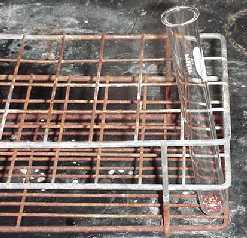
|
Place the 18 x 150 test tube containing the
copper sphere into your test tube rack and go to the
hood where the concentrated nitric acid is
located.
|

|
Carefully and quickly add 5 drops of the
concentrated nitric acid into the test tube and cover
it immediately with the 'acidic rainwater' pipet you
just prepared. The reaction which is occuring in the
test tube is;
Cu(s) + 4HNO3(aq) ---> Cu(NO3)2(aq)
+ 2NO2(g) + 2H2O(l)
Do not breath any of the brownish nitrogen
dioxide fumes.
Leave the mixture in the hood for ten minutes or
so to allow the fumes to disolve in the water in
'acidic rainwater' pipet.
|

|
While the reaction is occurring in the hood
fill two 18 x 150 mm test tubes with 10 mL of
distilled water each. Label one 'A' (acidic
rainwater) and the other 'N' (natural rainwater). Add
three drops of bromocresol green indicator to each
test tube. Record the color observed.
|

|
Weigh a marble chip using the electronic
balance. Remember to weigh solids into the plastic
weighing dish, not directly on the balance. Sometimes
solids will get spilled during transfer. PLEASE clean
up after you use the balance.
Record the mass of the chip to the nearest 0.001
g on the Results page.
|
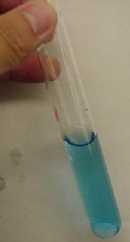
|
Place the marble chip into the test tube
labeled 'N' (normal rainwater).
|

|
Weigh a second chip and record its mass to
the nearest 0.001 g. Remember to weigh solids into
the plastic weighing dish, not directly on the
balance. Sometimes solids will get spilled during
transfer. PLEASE clean up after you use the balance.
|

|
Add this chip to the test tube labeled 'A'
(acidic rainwater).
|
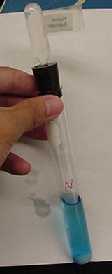
|
Obtain a disposable plastic pipet labeled
'normal rainwater', fill it with distilled water, and
insert it into a rubber stopper. Stopper the test
tube labeled 'N' with this plastic pipet.
Return to the hood where your original test tube
containing the copper sphere and nitric acid is
located. remove the stopper and plastic pipet labeled
'acidic rainwater' and immediately stopper the test
tube labeled 'A' (acidic rainwater).
|
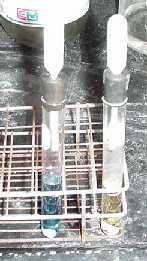
|
Carefully, squirt about 25 drops of the
acidic rainwater (rain) in the plastic pipet into the
test tube labeled 'A'. Record what you observe on the
Results page. Do not disturb this test tube for about
20 minutes.
|

|
After the 20 minutes have expired remove the
marble chips from each test tube. Be sure to mix the
marble chips. Use a paper towel to carefully and
delicately dry the marble chips.
|
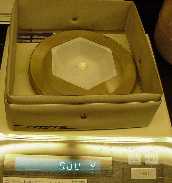
|
Reweigh each marble chip using the electronic
balance and record the masses on the Results page.
|